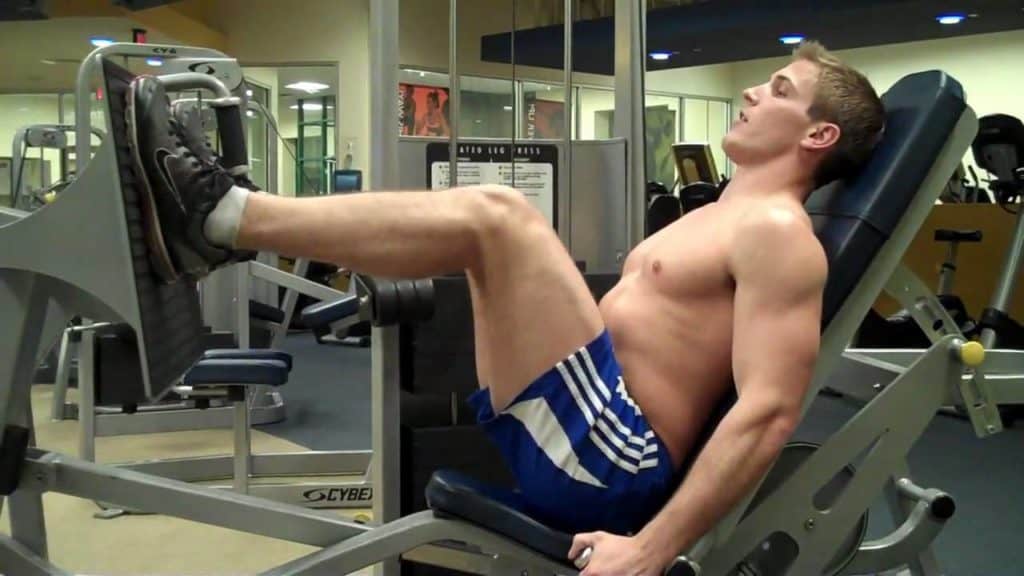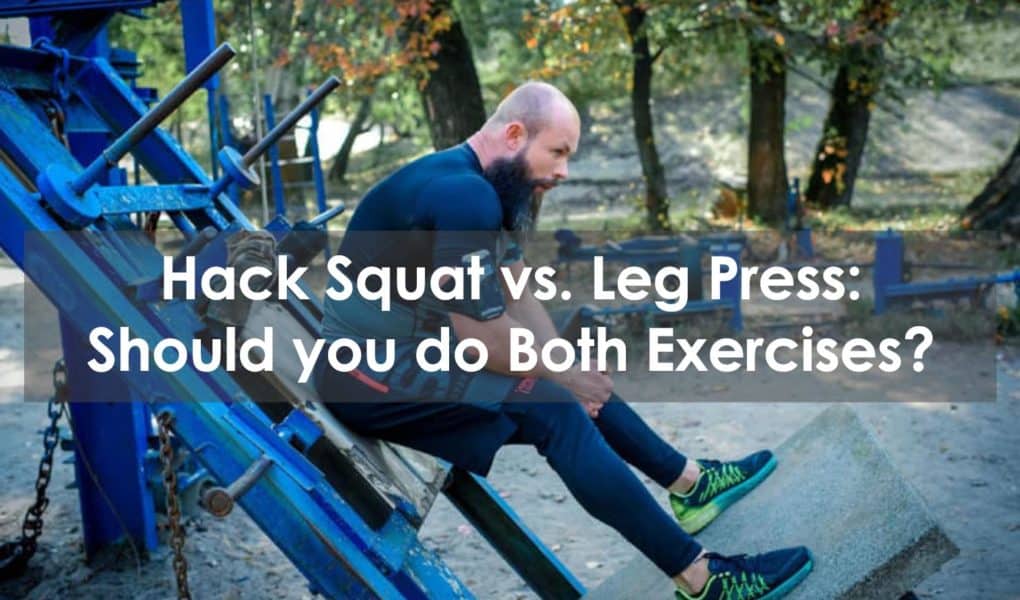There aren’t many types of leg exercises that come close to the squat when it comes to bang-for-your-buck. Some common gym machines have become staples in leg training, however.
Hack squat machines and leg press machines can be found in any big-box gym, and for good reason. They provide a safer, more supported way to lift more weight, and target specific areas of the legs.
But which machine is better for these purposes? This article will provide a breakdown of both movements, including pros, cons, and how to perform each. We’ll also answer some of the most common questions people have about these popular exercises.
Hack Squat
The hack squat is a lower body strength exercise that places the weights in a more posterior position than traditional squat machines.
This exercise can be done on a hack squat machine, on a smith machine, or with traditional weights like a barbell.
Hack squats utilize all the major leg muscles, including the glutes, quadriceps, and hamstrings. The angle and weight placement in these movements place emphasis on different muscles than the leg press machine.
Workouts aimed at hypertrophy and strength can include hack squats to reduce the risk of injury. Even a barbell hack squat has unique benefits if performed with stability and good form.
Pros of the Hack Squat
The hack squat machine has a greater range of motion than the leg press, achieving full hip extension at the top of the movement. This more closely mimics the natural squatting movements we do in day-to-day life.
Another benefit is that there are more upper body muscles involved in a hack squat because the weight is supported on the shoulders. Leg press exercises don’t have this option, making hack squat variations better for trunk stability.
Cons of the Hack Squat
Depending on your fitness goal, the version of the hack squat you perform may not afford you the same weight capacity as a leg press.
The average commercial gym may also stock standard squat racks and may not have the machines for hack squat exercises.
How to Do a Hack Squat
The following describes how to perform the hack squat in your leg workouts. This description may not apply if you’re using different equipment, such as a barbell.
Place the weight plates on either side of the hack squat machine. The starting position involves standing on the platform, with your shoulders under the shoulder pads.
Your foot position should be similar to that of what you use for a standard squat. Brace your core muscles, and descend into the squat.
Using your leg strength, complete the squat movement by pressing up to standing, avoiding locking out the knees.
You can also perform a reverse hack squat, which focuses more on the posterior chain. In this variation, use lower amounts of weight, and face the backrest.
These hack squat lifts are more of a hip hinge, recruiting the lower-body muscle fibers in your upper leg muscles.
Hack squats are amazing exercises to use in your routine if the normal squat causes excessive body fatigue.
Leg Press

The leg press may look like an upside-down hack squat machine at first, but these machines are actually quite different.
Training from a seated position, the leg press has a more limited range of movement. Highly engaging to the quad muscles, leg presses are one of the best compound movements for leg strength gains.
Pros of the Leg Press
You can do a leg press in any stance you like; narrow to wide, or high to low. For those with knee injuries, leg presses are a great way to train the legs with less force through the joint than other exercises like the knee extension.
Additional hypertrophy gains are possible with the machine version of a leg press, as you can use progressive overload to add a lot more weight to your leg day routine.
Cons of the Leg Press
While getting a great amount of hip flexion, the leg press is not as effective for hip extension, meaning it needs other exercises to target the glutes.
The angled machine can be tricky for some people to get in and out of, so those with a lower skill level might prefer the average hack squat in their leg training.
Those with bad knees need to be careful to have their feet shoulder-width apart and not too low to avoid knee injury.
How to Perform a Leg Press
After loading the weight stack appropriately, sit into the leg press machine and place the feet in a squat stance. Proper form involves lowering the weight until your knees are at around a 90-degree angle.
Gripping the safety handles, press up to the top – and DO NOT lock the knees out. Replace the safety catch and lower the platform gently.
What makes leg presses such a classic leg exercise and a great alternative to squats is the support given by the exercise machine to your back, allowing you to perform high-intensity compound exercises for the lower body joints without hurting your spine.
Leg press machines offer a versatile leg exercise, with many different variations. Check out our in-depth article on the leg press for more information.
Hack Squat vs. Leg Press: Which is Better?
So, which of these two movements is the better leg day exercise for people? Both are machine-based compound exercises, providing a leg-blasting lower-body workout for your adductor muscles, quadriceps muscles, outer thigh muscles, and more.
For a nice quad workout, the hack squat is an amazing way to focus on the front thighs. For a nice, all-around leg workout, the leg press gives plenty of work to the glutes and hamstrings as well – especially when using a wide stance over a standard shoulder-width stance.
Both moves have less potential for injury than traditional squats. With a variety of stances, strength training enthusiasts can increase strength and choose the degree of glute or quad involvement they want.
The leg press is probably the better option for beginners, with an easier setup and the fact it’s easier to fix bad form on a leg press than struggle with the form for hack squats. They are a slightly more awkward movement for new lifters.
A quick note here to consult a gym staff member or personal trainer for technique tips for either machine.
Athletes may prefer hack squats over leg presses as a supplement to their squat barbell variations. Machine squats on the hack squat more closely mimic athletic performance due to the greater hip extension.
Of course, athletes will have to utilize conventional squats and other barbell lifting techniques at the elite level.
There are a number of alternate exercises training the lower-body muscles if any assistance work is needed to support the major muscles trained by these two moves.
Conclusion
For a tougher workout for your legs, both the hack squat and leg press are great options if you’re worried about the reduced stability of your stabilizer muscles.
The fantastic benefits of these two moves may be more subject to equipment availability in your gym since you might want to include both in your leg routine!
Frequently Asked Questions
Are hack squats as good as regular squats?
The biggest benefit of hack squats is that the pad angle allows you to decide whether you want to focus more on quadriceps activation, glute activation, or hamstring activation.
The support from the heavy equipment lets you achieve greater hypertrophy stimulus, making them great for bodybuilding goals and jump performance alike.
That being said, nothing should replace traditional squats if you have the mobility, strength, and technique to perform them. Use hack squats as a backup move to help your standard squats.
How often should I do hack squats?
Add hack squats into your lower body weekly workouts twice a week. You can vary your routine with a narrower stance, or a wider position to place different emphasis on the leg muscles.
The weight loads and rep ranges will depend on your goals. Excessive weight and low reps are great for maximal strength, whereas exercise plans for endurance or weight loss may use higher reps and lighter weights for their lower-body exercises.
Are hack squats bad for knees?
Hack squats are a machine-supported exercise, making them safe and supportive for the knees.
However, if feet placement is too low on the foot plate, over-extension can cause unnecessary strain on the quadriceps tendon at the front of the knees.
Like any exercise, assuming you use correct form and appropriate load, the hack squat is perfectly safe for your knees.







